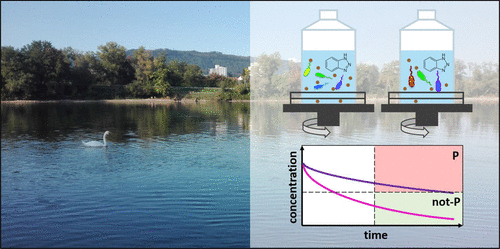当前位置:
X-MOL 学术
›
Environ. Sci. Technol. Lett.
›
论文详情
Our official English website, www.x-mol.net, welcomes your
feedback! (Note: you will need to create a separate account there.)
Biotransformation of Chemicals in Water–Sediment Suspensions: Influencing Factors and Implications for Persistence Assessment
Environmental Science & Technology Letters ( IF 8.9 ) Pub Date : 2020-10-06 , DOI: 10.1021/acs.estlett.0c00725 Carolin Seller 1, 2 , Mark Honti 3 , Heinz Singer 1 , Kathrin Fenner 1, 2
Environmental Science & Technology Letters ( IF 8.9 ) Pub Date : 2020-10-06 , DOI: 10.1021/acs.estlett.0c00725 Carolin Seller 1, 2 , Mark Honti 3 , Heinz Singer 1 , Kathrin Fenner 1, 2
Affiliation

|
Chemicals’ half-lives derived from biotransformation simulation studies are central metrics for persistence assessment in international regulatory frameworks. To determine the persistence of chemicals released to the aquatic environment, paradigm shifts in recent and ongoing revisions of chemical legislation assign increasing importance to OECD 309 simulation studies. OECD 309 studies were designed to target biotransformation in natural water (pelagic test) or in water amended with sediment (suspension test). Suspension tests bear several advantages over the pelagic test, most importantly, employing higher bacterial cell densities, which promote biotransformation of various chemicals at observable rates. However, experience with suspension tests is limited. In this study, we followed the fate of 43 pharmaceuticals, pesticides, and industrial chemicals in various suspension test setups and elucidated parameters influencing biotransformation kinetics and half-lives derived thereof. Besides striking intrastudy variability between replicates, we found that differences in sediment origin and bacterial cell density resulted in chemical half-lives that were different by up to 2 orders of magnitude, making persistence classification rather uncertain. However, data suggested that test systems employing bacterial cell densities close to the upper limit of what is commonly observed in natural surface waters (i.e., 107 cells mL−1) yielded increased and more uniform biotransformation of chemicals.
中文翻译:

水—悬浮液中化学物质的生物转化:影响因素和持久性评估的意义
从生物转化模拟研究得出的化学品半衰期是国际监管框架中持久性评估的主要指标。为了确定释放到水生环境中的化学物质的持久性,最近和正在进行的化学法规修订中的范式转移给OECD 309模拟研究越来越重要。经合组织309研究旨在针对天然水中的生物转化(浮游试验)或经沉淀物修正的水中的生物转化(悬浮试验)。悬浮试验比浮游试验具有几个优势,最重要的是,采用更高的细菌细胞密度,可以以可观察的速率促进各种化学物质的生物转化。但是,悬挂测试的经验有限。在这项研究中,我们遵循了43种药品,农药,以及各种悬浮测试设置中的工业化学品以及影响其生物转化动力学和半衰期的阐明参数。除了发现重复之间的研究内变异性外,我们发现沉积物来源和细菌细胞密度的差异还导致化学半衰期相差最多2个数量级,这使得持久性分类变得相当不确定。但是,数据表明,采用细菌细胞密度的测试系统接近自然地表水中通常观察到的上限(即10 我们发现,沉积物来源和细菌细胞密度的差异导致化学半衰期相差最多2个数量级,这使得持久性分类非常不确定。但是,数据表明,采用细菌细胞密度的测试系统接近自然地表水中通常观察到的上限(即10 我们发现,沉积物来源和细菌细胞密度的差异导致化学半衰期相差最多2个数量级,这使得持久性分类非常不确定。但是,数据表明,采用细菌细胞密度的测试系统接近自然地表水中通常观察到的上限(即107细胞mL -1)产生增加的化学物质,并且生物转化更加均匀。
更新日期:2020-11-12
中文翻译:

水—悬浮液中化学物质的生物转化:影响因素和持久性评估的意义
从生物转化模拟研究得出的化学品半衰期是国际监管框架中持久性评估的主要指标。为了确定释放到水生环境中的化学物质的持久性,最近和正在进行的化学法规修订中的范式转移给OECD 309模拟研究越来越重要。经合组织309研究旨在针对天然水中的生物转化(浮游试验)或经沉淀物修正的水中的生物转化(悬浮试验)。悬浮试验比浮游试验具有几个优势,最重要的是,采用更高的细菌细胞密度,可以以可观察的速率促进各种化学物质的生物转化。但是,悬挂测试的经验有限。在这项研究中,我们遵循了43种药品,农药,以及各种悬浮测试设置中的工业化学品以及影响其生物转化动力学和半衰期的阐明参数。除了发现重复之间的研究内变异性外,我们发现沉积物来源和细菌细胞密度的差异还导致化学半衰期相差最多2个数量级,这使得持久性分类变得相当不确定。但是,数据表明,采用细菌细胞密度的测试系统接近自然地表水中通常观察到的上限(即10 我们发现,沉积物来源和细菌细胞密度的差异导致化学半衰期相差最多2个数量级,这使得持久性分类非常不确定。但是,数据表明,采用细菌细胞密度的测试系统接近自然地表水中通常观察到的上限(即10 我们发现,沉积物来源和细菌细胞密度的差异导致化学半衰期相差最多2个数量级,这使得持久性分类非常不确定。但是,数据表明,采用细菌细胞密度的测试系统接近自然地表水中通常观察到的上限(即107细胞mL -1)产生增加的化学物质,并且生物转化更加均匀。











































 京公网安备 11010802027423号
京公网安备 11010802027423号